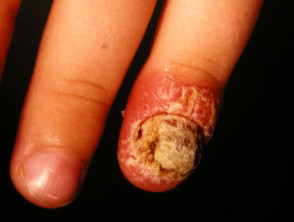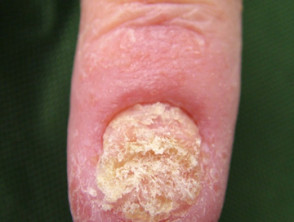What is parakeratosis pustulosa?
Parakeratosis pustulosa describes a deformed fingernail or toenail surrounded by red, often scaly skin. It usually affects the thumb or index fingernail of young children, but occasionally involves another digit including a toenail. It is three times more common in girls.
It often starts with reddening of the skin under the free margin of the thumb or index finger nail. The redness later extends down to the nail fold resulting in swelling and loss of the cuticle. Thickened skin pushes up and deforms the nail plate.
Parakeratosis pustulosa is not itchy, but it may be a little painful.
The cause is unclear.
What does an affected nail look like?
The following signs may be seen.
- Subungual hyperkeratosis (skin thickening under the distal edge of the nail)
- Onycholysis (lifting of the nail plate off the nail bed)
- Onychomadesis (shedding of the nail plate)
- Pitting
- Transverse ridging
- Ragged or absent cuticles
- Red skin around the nail
- Blisters on the fingertips
These signs make it hard to distinguish from other skin conditions such as psoriasis and atopic dermatitis so although common, it is often misdiagnosed.
Other conditions that may appear similar include tinea pedis and tinea unguium, paronychia, acrodermatitis continua of Hallopeau and other types of hand dermatitis.
Parakeratosis pustulosa
What investigations should be done?
Parakeratosis pustulosa is a clinical diagnosis, so investigations are performed to rule out other nail conditions.
- Swabs may be helpful in culturing microorganisms associated with paronychia such as Staphylococcus aureus, Streptococcus pyogenes, Pseudomonas species, Proteus species, anaerobes or Candida albicans.
- Tinea infection can be confirmed by the presence of fungal hyphae in skin scrapings (mycology).
- Biopsy can differentiate atopic dermatitis and psoriasis but is rarely necessary.
What treatments are available?
No specific therapy is used for parakeratosis pustulosa. The following have occasionally been found useful.
- Stopping thumb sucking
- Emollients
- High potency topical steroids
- Topical retinoids
- Calcipotriol / calcipotriene
Parakeratosis pustulosa usually improves with time. Some affected children later develop psoriasis.

